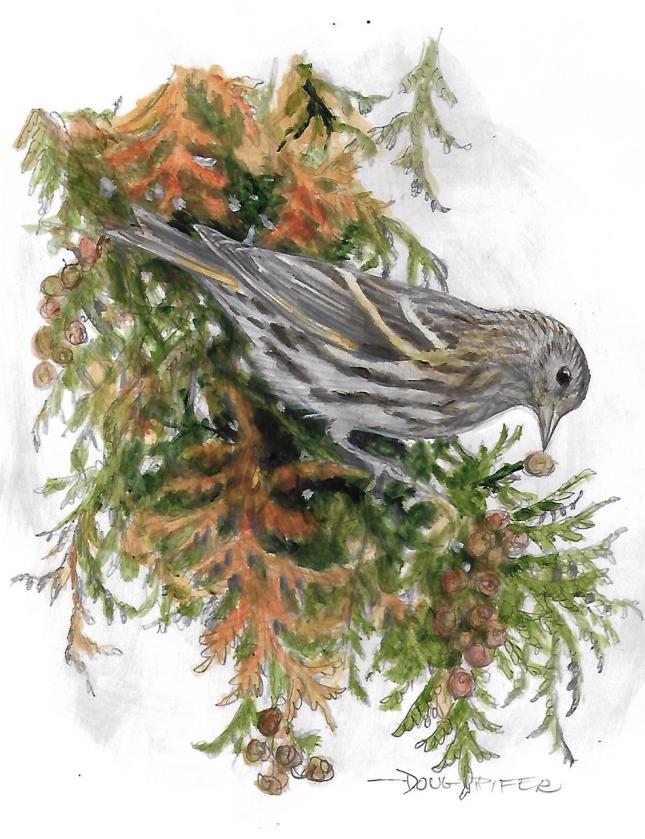SISKINS ARE WANDERERS FROM THE NORTH
By Doug Pifer
Last month I heard a different bird call coming from one of our tall Arborvitae trees in the front yard. When I heard it again a few days later I recognized it—pine siskins! I was excited to see a flock of about a hundred land in the same tree.
They were about the same size as American goldfinches, with a similar call and undulating flight. My wife remarked that, compared to goldfinches, flocks of siskins fly with lightness. Natives of Canada’s coniferous forest, pine siskins are considered “irruptive” in most of the United States, which means they show up sometimes during certain years. Irruption in birds is generally believed to be in response to a lack of food in their normal range. Most pine siskin irruptions occur in the fall and winter, but sometimes these birds hang around till spring and even nest here.
Pine siskins are specially adapted to extracting seeds from the cones of pine, spruce, fir and cedar trees. The Arborvitae trees in our front yard have produced a bumper crop of seeds this year. Also called northern white cedar, Arborvitae means “tree of life.” French explorer Jacques Cartier gave it this name after his men were saved from illness, possibly scurvy, by drinking tea that native Canadian people brewed from its leaves and twigs.
Arborvitae trees are likewise important to pine siskins. They depend upon the seeds for food and they nest and roost among the branches. In fact, the pine siskins’ range roughly overlaps the range of this northern forest tree.
Setting up the spotting scope on our front porch, I focused on a couple of pine siskins as they hung upside down from the evergreen branches, extracting seeds from the small cones. Up close, they were brown above, creamy white below, marked with bold dark brown streaks. The tail was deeply notched, the folded wings long and pointed. They looked much like striped goldfinches with thinner bills. Viewed head-on, that unusual bill made the bird’s face look like a clown with a pointed ice cream cone strapped over its nose.
Some pine siskins flash a bit of yellow when spreading their wings and tail. When the birds are at rest, the color is mostly concealed except for a yellow tinge in the wings. Those I viewed through my scope showed none of this color, nor did I see yellow on any of the flying birds. Researchers say the amount of yellow varies between individuals, irrespective of season, age or sex.
It was remarkable how quiet they were. Their flight calls are soft and buzzy, almost whispered. After looking for what I thought were a couple of siskins feeding in our tree, I was startled to see as many as thirty of them fly from one tree to the other.
Checking the internet, I noticed that folks in Pennsylvania, New York and other eastern states have been reporting pine siskins since September. When pine siskins appear, sometimes redpolls, evening grosbeaks and other unusual and beautiful birds from the north also wander into the United States during the winter. Will 2020 be one of those years?
##

